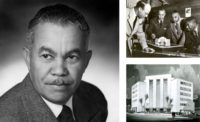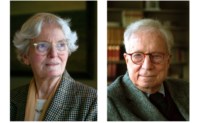For the first time since the American Institute of Architects (AIA) began giving the prize in 1907, a woman has been awarded the Gold Medal—even though the woman is no longer alive. Julia Morgan (1872-1957) is the first woman to receive the medal, considered the profession’s highest honor, and the eighth architect to receive it posthumously. The Gold Medal is awarded to an individual whose work has had a lasting influence on the theory and practice of architecture.
It is no accident Morgan won this year, but rather the result of an orchestrated campaign. Julia Donoho, a northern California architect and lawyer who is on the California Council of the AIA, first proposed Morgan’s name. California Senator Dianne Feinstein wrote the Gold Medal Selection Committee in support: “Julia Morgan is unquestionably among the greatest American architects of all time and a true California gem.” Maria Shriver, ex-wife of the former California Governor Arnold Schwarzenegger, also wrote the committee, noting that Morgan “through the buildings she created… influenced the world of architecture, the woman’s movement and our notions of hospitality.” And Chicago architect Jeanne Gang, of Studio Gang, presented the nomination to the AIA’s board. “Julia Morgan was a true superstar,” said Gang. “Julia received many glamorous commissions, but she continued to devote a large part of her talent to empowering the poor and vulnerable. This and many of the other themes in her work and practice make her a powerfully relevant model for contemporary architects.”
Morgan “was a game changer from the get go,” wrote Denise Scott Brown in her recommendation letter to the selection committee. Brown herself was the subject of a passionate campaign and petition this year, signed by some 19,000 people to date, demanding that she be given a retroactive Pritzker Prize in acknowledgement of her contributions to the 1991 Pritzker, which was solely awarded to her collaborator and husband Robert Venturi. The surrounding publicity focused attention on the lack of architecture prizes given to women, as well as the obstacles that remain for women architects. Inspired in part by the Scott Brown petition and a desire to honor collaboration, the AIA voted in June to allow the Gold Medal to be awarded to two individuals beginning with the 2015 cycle.
Meanwhile, Morgan's legacy, and her incredibly prolific career, will be celebrated at the 2014 AIA convention in Chicago in June. “She made a long-lasting contribution to the profession by demonstrating that a woman could not only break into a field dominated by men but also create a significant body of work that endures among the highest accomplishments in 20th-century design,” Michael Graves, the 2001 AIA Gold Medal Winner, wrote in his recommendation. “Morgan experimented with formal strategies of place making and symmetry before Modernism emerged, and she adapted historic motifs with modern ease, showing us how to revere history and design for a new era.”
Between 1904, the year Morgan opened her architecture office, and 1950, the year she retired, she designed more than 700 buildings, many more than her famous contemporary Frank Lloyd Wright. These were predominantly in California and include churches, museums, hotels, hospitals, schools, clubs, and private residences. Among them are William Randolph Hearst’s famous 165-room castle in San Simeon, California, the Greek Theater (an open-air Greek amphitheater based on Epidaurus) for the University of California at Berkeley, six academic buildings at Mills College, St. John’s Presbyterian Church in Berkeley, and the Asilomar YWCA in Pacific Grove, California (one of 28 YWCAs she designed).
Morgan was a woman of firsts. Born in San Francisco, she was one of the first women to obtain a B.S. in engineering from the University of California, Berkeley, the first woman to graduate from the Ecole des Beaux-Arts in Paris—then the top architectural design school in the world—and, in 1904, the first woman to obtain an architectural license in California.
Due to her classical education and her travels across Europe making careful drawings and sketches, she was capable of working in diverse styles, including Georgian, Tudor, Romanesque Revival, Gothic Revival, Arts and Crafts, Spanish Colonial, even Moorish.
“She was an architect ahead of her time; she designed her houses for her clients,” Morgan’s goddaughter Lynn Forney McMurray writes in the foreword to Julia Morgan: Architect of Beauty by Mark Anthony Wilson. “She considered what they wanted and then let them know if their ideas were possible.”
Morgan’s work still resonates today. “Her preoccupation with light, with the relationship of a structure to its site, with flexibility of plan, with indoor-outdoor living and with the use of color and decoration make her work relevant to contemporary designers,” Sara Holmes Boutelle writes in her excellent biography Julia Morgan: Architect.
She was also a proto-environmentalist, influenced by her college study with the California architect Bernard Maybeck, who taught organic design, the use of natural materials, and the integration of buildings into their sites. “She was America’s first truly independent, fulltime woman architect,” Mark Wilson writes. “Indeed, she was a cultural revolutionary in a flowered hat.”











Post a comment to this article
Report Abusive Comment